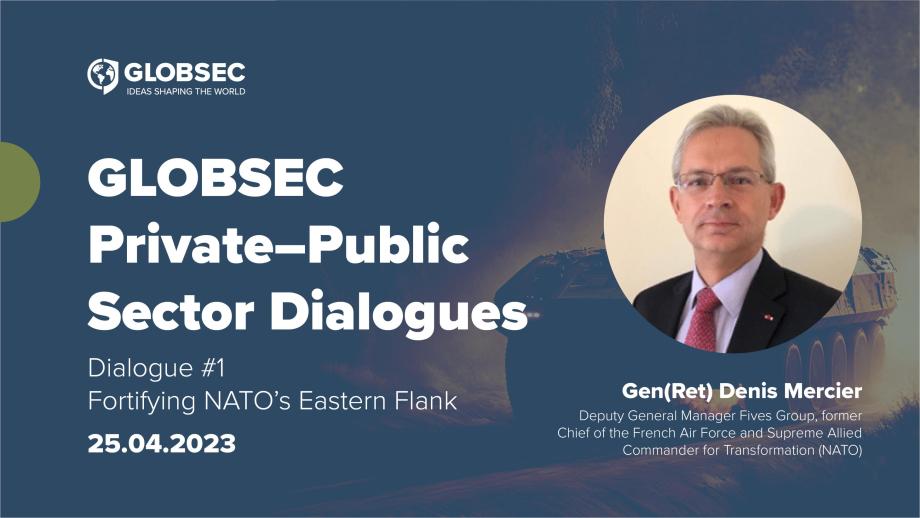GLOBSEC Private-Public Sector Dialogue #1: Deterrence of NATO's Eastern Flank

The first dialogue in the GLOBSEC Private-Public Sector series focused on the renewed role of deterrence in the countries of NATO´s Eastern flank. This initial session brought together key stakeholders from public and private sectors to explore various aspects of deterrence in the region. With expert insights from Gen Denis Mercier, former Supreme Allied Commander Transformation in NATO, and lively discussions in the two breakout groups, the dialogue fostered a valuable exchange of ideas, helping to identify potential synergies and inform future defence cooperation and situational awareness efforts.
The crisis management role of NATO now needs to shift to a proper defence and deterrence posture. Agenda setting and optimising the process of defence planning is essential, though it needs to entail industrial and governmental spheres. In order to adapt, we need to focus on space and cyber capabilities. The war in Ukraine shows the need for transforming the defence planning process. As the areas of cybersecurity and innovation will be crucial to disrupt the enemy. This is tied to close cooperation with the industrial capacities accounting for those needs, even in times of peace.
Breakout room #1: Fortifying the Eastern Flank: Exploring Defence Capabilities in the Region
Participants in this group stressed the need for a shift from crisis management to a proper defence and deterrence posture. They emphasized the importance of space and cyber capabilities, data integration, and agile command and control systems. In addition, the discussion also touched on the changing nature of warfare, the need for decentralization of forces, and the role of air superiority in modern conflict.
Policy Recommendations
- Optimize the defence planning process: Involve the whole governmental sphere and the industry in defence planning, with a focus on space and cyber capabilities.
- Enhance data-gathering capabilities: Invest in the technological infrastructure required for data processing and analysis to enable better decision-making on the battlefield.
- Develop agile command and control systems: Enable the decentralization of forces by implementing quick decision-making abilities and better situational awareness.
- Seize the potential for air superiority: Address the adversary´s anti-aircraft capabilities to unlock the full potential of air superiority in modern conflict.
- Protect civilian populations: Improve the position of forces capable of defending Eastern flank countries from day one to ensure the safety of civilians during conflicts.
- Unify ammunition types: Increase interoperability, procurement effectiveness, and lower costs by standardizing ammunition types used within the Alliance.
- Encourage tailored procurement requirements: Consider geographical and strategic specifics in procurement processes to ensure effective defence capabilities.
- Foster cooperation between national governments, NATO, and the EU: Coordinate defence efforts to strengthen the Eastern flank and ensure a unified approach to deterrence.
- Focus on the forward positioning of assets by securing the infrastructure, logistics and training for that purpose. This is the only sustainable way of deploying conventional forces forward without incurring the high costs associated with the permanent or rotational deployment of brigade-level forces.
Breakout room 2: Strengthening the Industrial Base and Streamlining Procurement Processes
Participants in the second group shared their insights on reinvigorating of the European defence industry, while emphasizing the importance of innovation and new technology. Private sector representatives also discussed the need for long-term planning and clarity on procurement plans of respective states, while acknowledging the need for some military equipment to be available off the shelf.
Policy Recommendations
- The defence industry needs predictability: For a long-term planning and investment, governments should provide clear guidance on their plans for the next 5-10 years, enabling the industry to anticipate demand and allocate resources.
- Engage the defence industry early in military planning processes: Promote resource pooling, multi-country compatible weapon systems, and a better understanding of each nation´s military development needs by involving the defence industry from the requirement definition stage.
- Encourage rapid adoption and application of innovation within NATO countries: Allies should study the Ukrainian approach to learn how to quickly integrate new technologies and apply similar strategies in order to enhance their own capabilities.
- AI as a capability enabler: The software-driven battlefield is becoming a reality, existing platforms can be made interoperable, capabilities can be enhanced, and operational effectiveness increased.
- Develop strategies to expand and disperse NATO forces: The return to mass requires a re-evaluation of the defence industry´s capacity to provide necessary equipment 3 and support for larger-scale operations.
- Increase demand for defence products and services: States need to shape demand and drive industry. Active engagement and clear communication between the government and the defence industry will encourage innovation and responsiveness.
- Establish clear guidelines and strategies for wartime and peacetime needs: Governments should develop comprehensive plans that outline resource allocation, equipment procurement, and force composition in both wartime and peacetime, to ensure maintaining of strategic communication, preparedness, and deterrence.
- Prioritize acquiring the necessary basics: The pursuit of perfecting modern equipment and technology may overshadow the access to essential equipment and resources, which should be the primary objective for both governments and the defence industry.
- Focus on attracting and developing talent within the defence industry without trying to retain them indefinitely: By fostering a dynamic and innovative environment, the industry can stay ahead of emerging threats and adapt to changing circumstances.